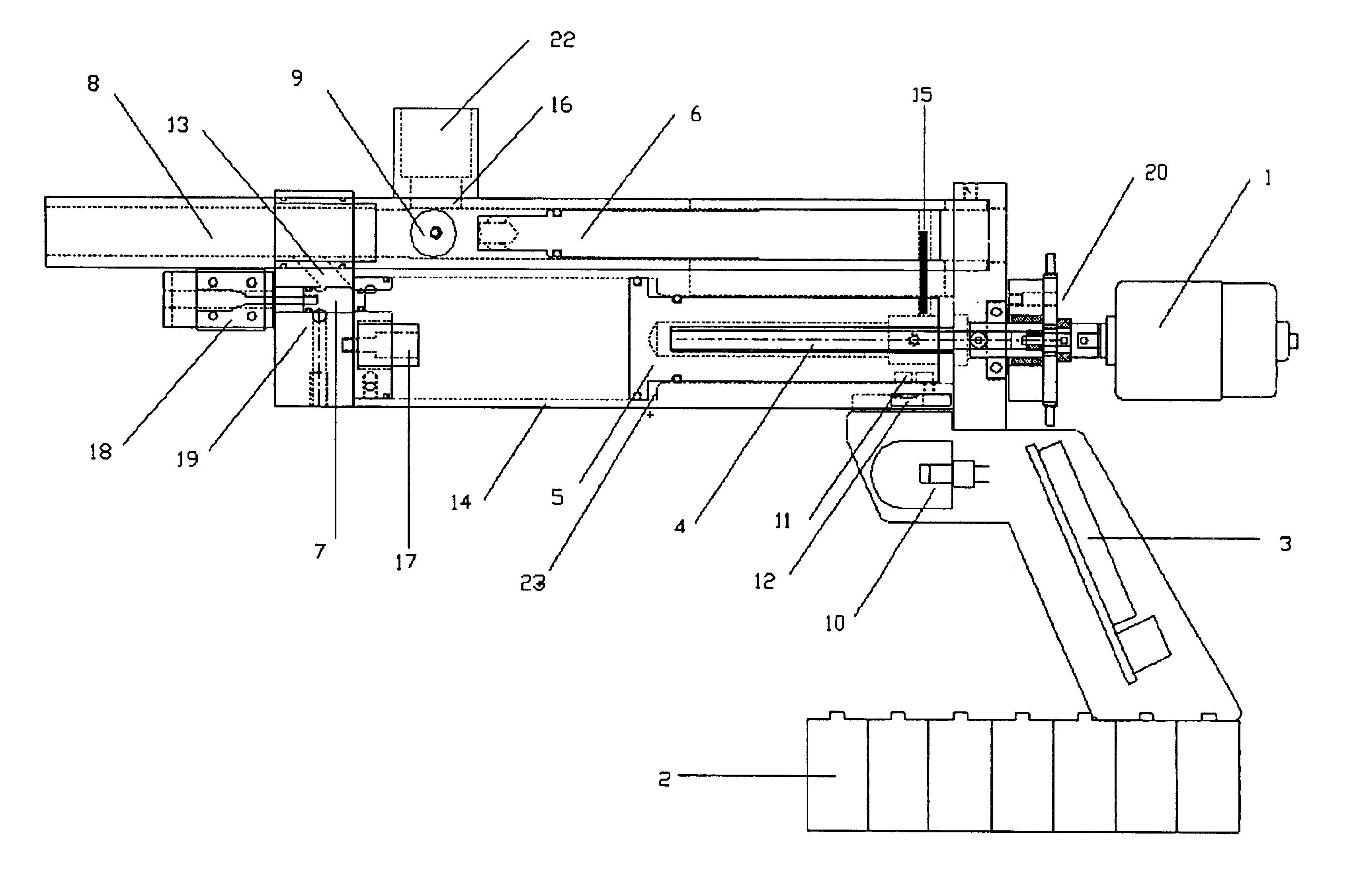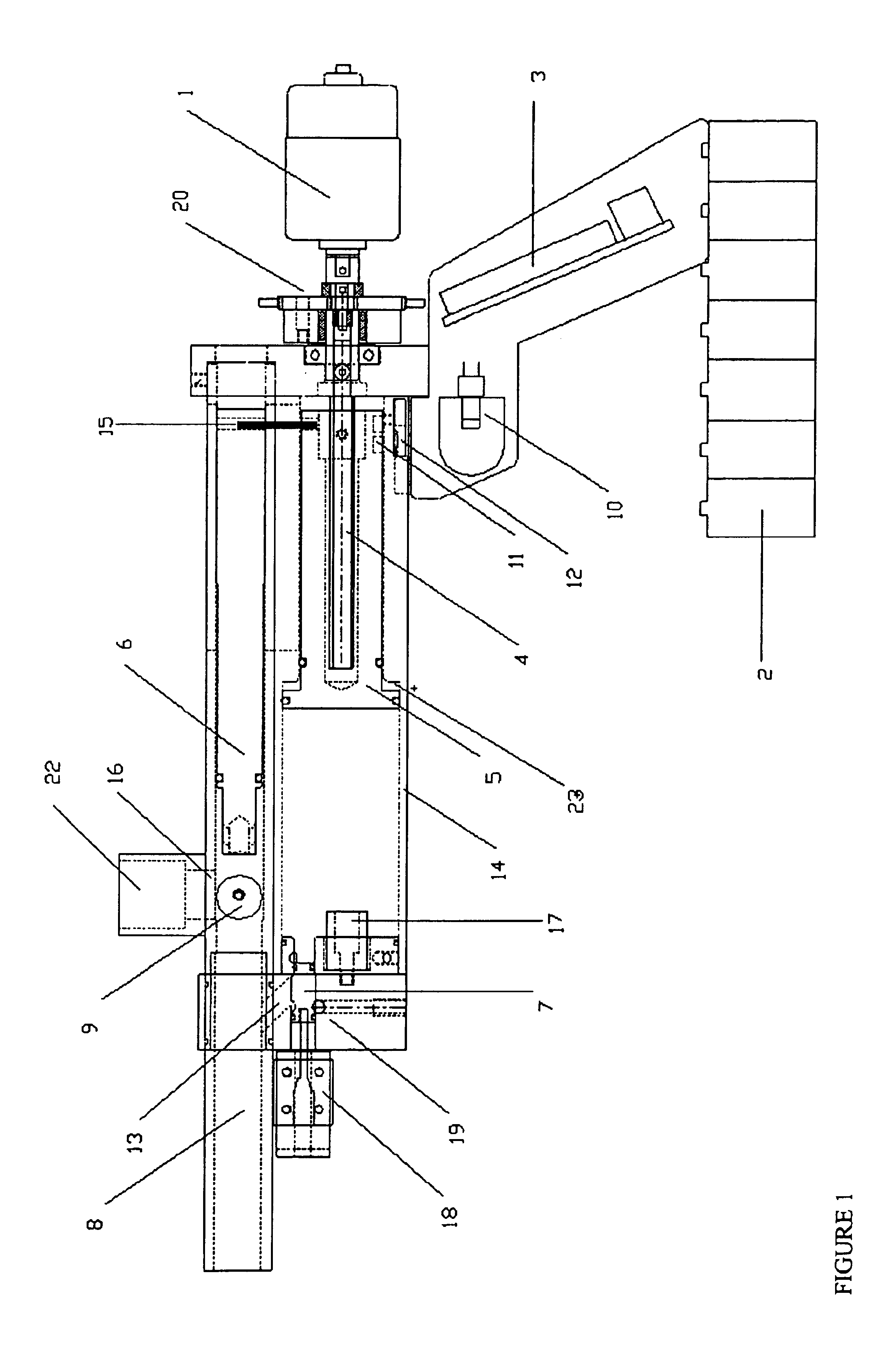Filling, transporting and using such a canister represents a significant inconvenience and burden for the user.
This further increases the cost and complexity of such an air gun.
Furthermore, these tanks store an incredible amount of energy which, if released suddenly through a tank fault, could represent a significant safety factor.
Disposable cartridges, which can be used in less costly air guns, significantly increase refuse issues.
All of these patents still suffer from the major inconvenience and potential safety
hazard of storing a large volume of highly compressed gas within the air gun.
Additionally, as they combine electronic control with the propulsion method of stored compressed gas, the inherent complexity of the mechanism increases, thus, increasing cost and reliability issues.
While this addresses the ability of
multiple modes of fire, it does not solve the fundamental propulsion problem associated with gas cylinders and, in addition, it is expensive and complicated.
Problems with this method include the need to “cock” the spring between shots.
Thus, it is only suitable for
single shot devices and is limited to very slow rates of fire.
Furthermore, the spring results in a double
recoil effect when it is released.
Additionally, the spring air rifles require a significant amount of maintenance and, if dry-fired, the mechanism can be damaged.
Finally, the effort required for such “cocking” is often substantial and can be difficult for many individuals.
While this innovation solves the problem of cocking effort, the resulting air
rifle still suffers from a complicated mechanism, double
recoil and maintenance issues associated with the spring piston
system.
Again, the use of indirect means to store the electrical energy in a spring before release to the piston to push the projectile results in an inefficient and complicated
assembly.
Furthermore, the springs in such systems are highly stressed
mechanical elements that are prone to breakage and which increase the weight of the air gun.
In this case, the device is for non-portable operation.
The third technique, using a
hand pump to pressurize the air, is often used on low end devices and suffers from the need to pump the air gun between 2 to 10 times to build up enough air supply for sufficient projectile velocity.
This again limits the air
rifle or paintball gun to slow rates of fire.
While this solves the obvious problem of manually pumping chamber up in order to fire a gun, these devices suffer from the inability to store sufficient energy in the air
stream.
Solenoids are inefficient devices and can only convert very limited amounts of energy due to their operation.
Furthermore, since the air
stream is coupled directly to the projectile in this technique, the projectile begins to move as the air is being compressed.
This limits the ability of the solenoid to store energy in the air stream to a very short time period and further relegates its use to low energy air rifles.
This results in a very energetic piston
mass similar to that shown in spring piston designs and further results in the undesirable double
recoil effect as the piston
mass must come to a halt.
Additionally, this technique suffers from dry-fire in that the air is compressed between the piston and the projectile.
A missing projectile allows the air to communicate to the
atmosphere through the
barrel and can damage the mechanism in a dry-fire
scenario.
Although this solves the issue of sufficient power, it is no longer considered an air
rifle as it becomes a
combustion driven gun.
Moreover, it suffers from the aforementioned disadvantages including complexity and difficulty in controlling the firing sequence.
Although this solves the issue of double recoil, it is not suitable to a portable
system due to inefficiencies of compressing air and the large tank volume required.
When air is used in this fashion, it compresses via adiabatic means, but the heat of compression is dissipated due to the large volume of air and the subsequent storage in a tank.
In order to overcome the variation in air pressure, further expense and complexity in terms of valving and regulators must be added.
Again, due to the large volume of air between the compression means and the projectile, much of the heat of compression is lost leading to a very inefficient operation.
Additionally, this patent teaches of a continuously operating device which suffers from a significant
lock time (time between trigger pull and projectile leaving the
barrel) as well as the inability to run in a semiautomatic or
single shot mode.
Further disadvantages of this device include the pulsating characteristics of the air stream which are caused by the release and reseating of the
check valve during normal operation.
Limitations of this approach include difficulty in achieving high projectile velocity since the transfer of energy must be done extremely rapidly between the impacting hammer and the projectile.
Additionally, this method suffers from the need to absorb a significant
impact as the solenoid
plunger must stop and return for the next projectile.
Since the solenoid
plunger represents a significant fraction of the moving
mass (i.e. it often exceeds the projectile weight) this type of
system is very inefficient and limited to low velocity, low energy air guns as may be found in toys and the like.
The spring is “cocked” via an
electric motor, but again, this does not overcome the prior mentioned limitations.
All of the currently available devices suffer from a number of disadvantages, some of which include:1. Difficult operation.
Cocking or pumping air rifles can be
time consuming and a physical chore.2. Inability to rapidly move between single fire, semiautomatic, burst or automatic
modes.
Traditional air rifles at carnivals and the like are tethered to a
compressed air supply or due to inefficient compressor operation require a large power source such as a wall outlet.5. Double recoil effects.6. Complicated mechanisms and air
porting schemes leading to potentially expensive production costs and reliability issues.7. Inefficient usage and / or
coupling of the compressed air to the projectile resulting in low energy projectiles and large energy input requirements.
 Login to View More
Login to View More  Login to View More
Login to View More 


